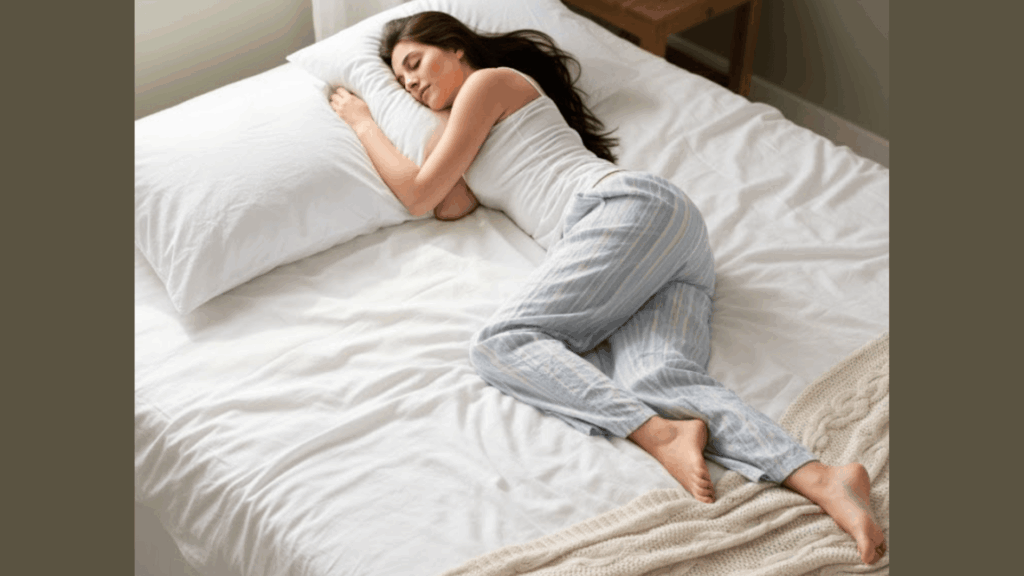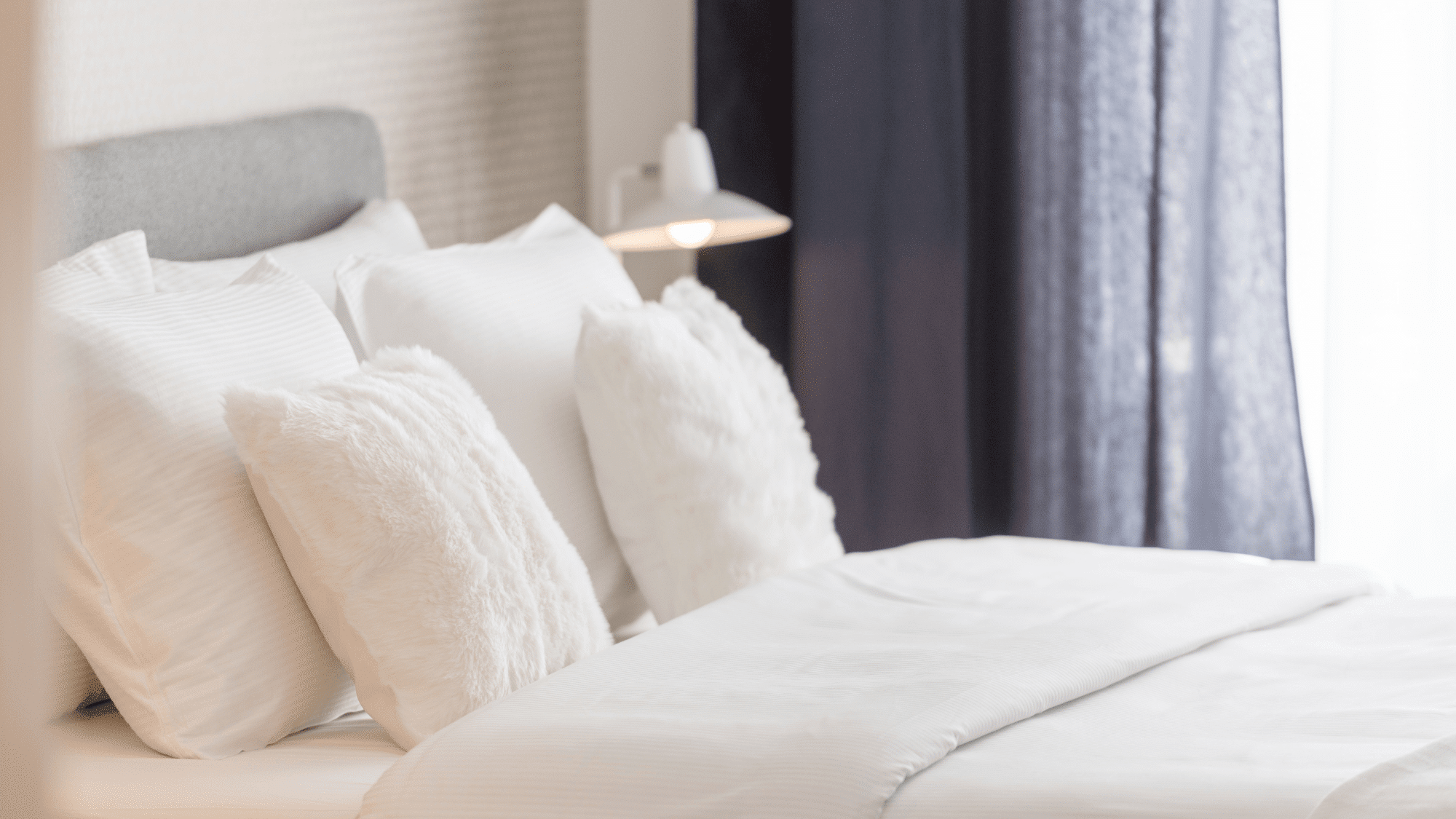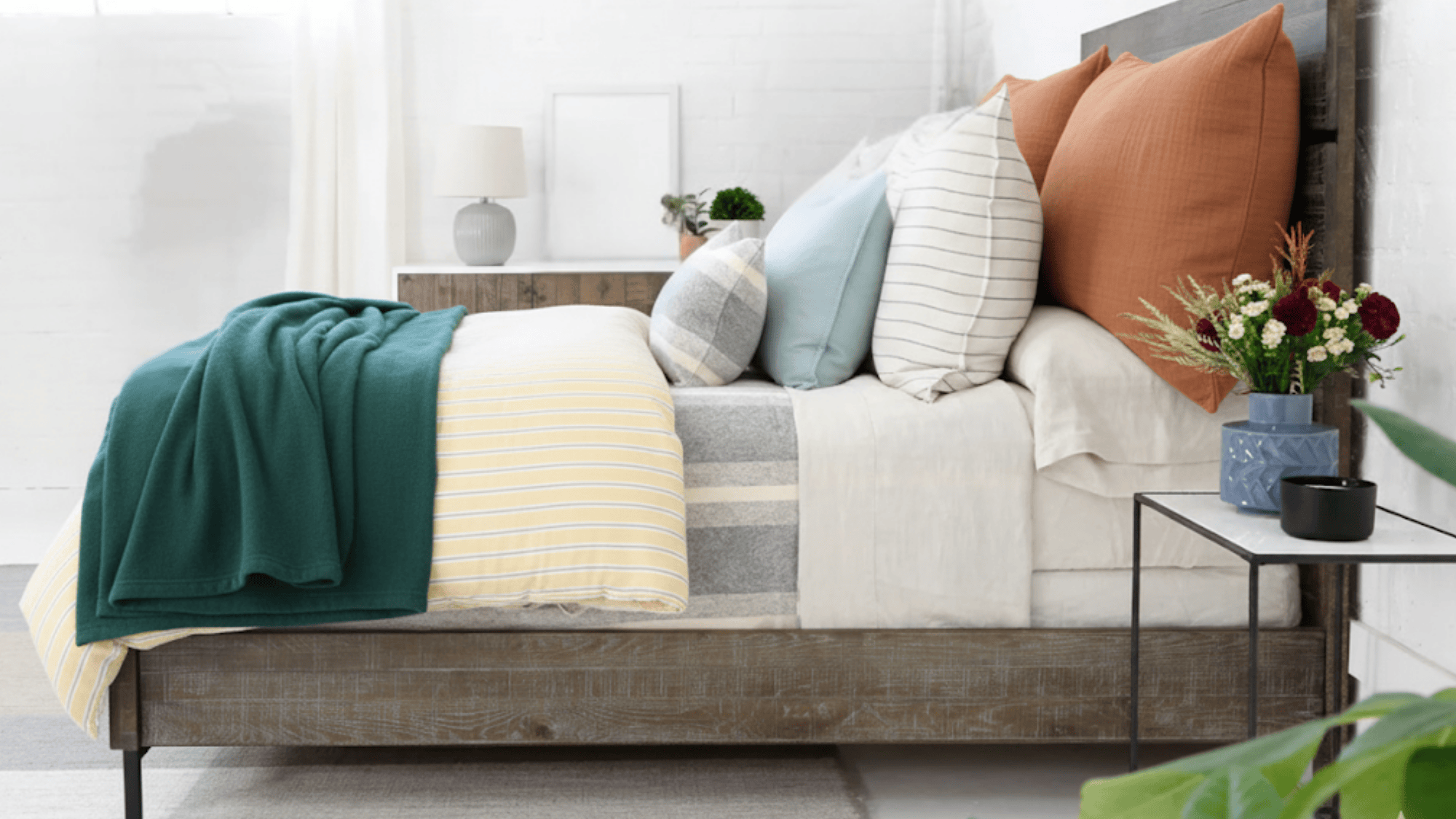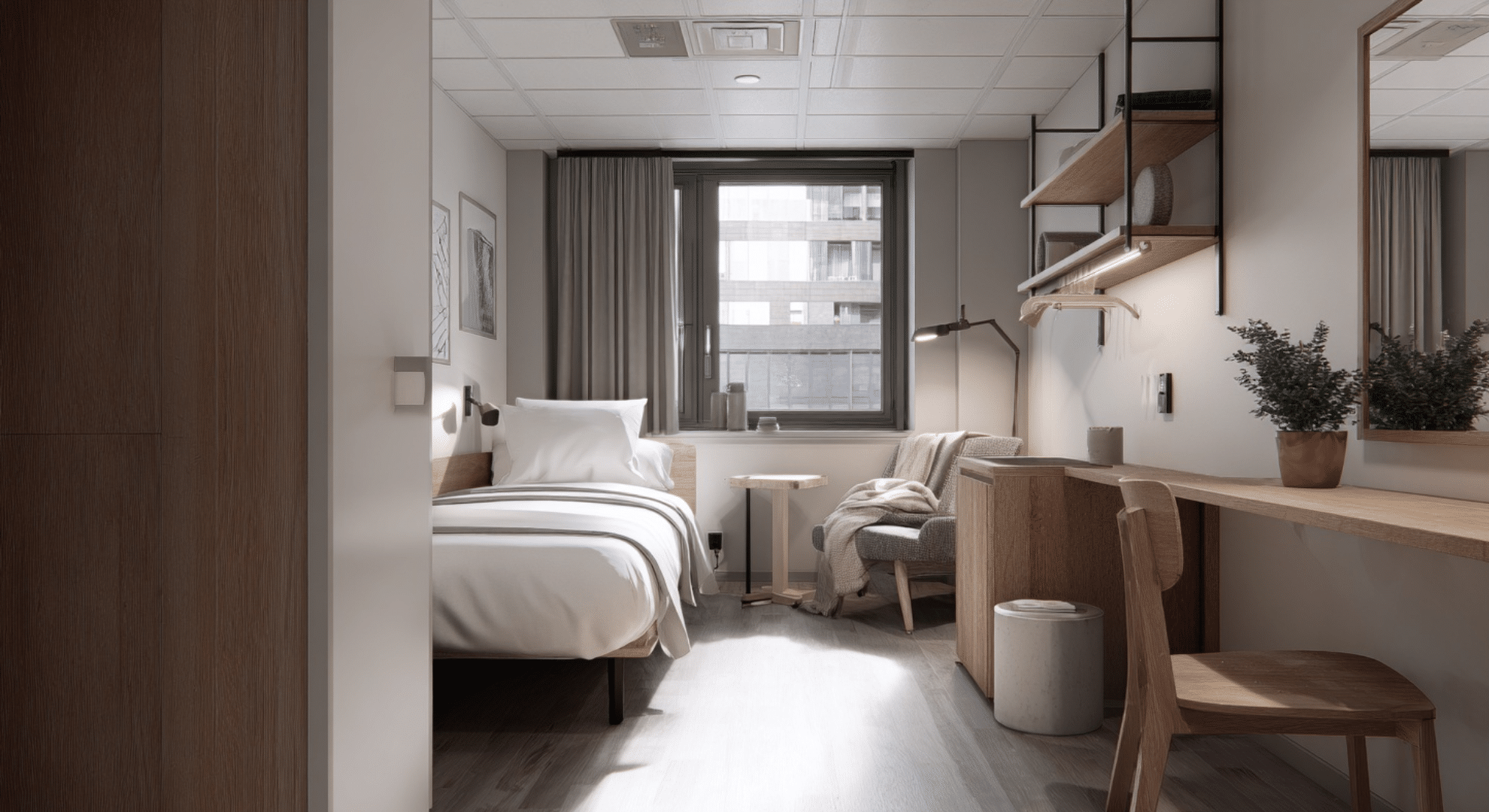If you often wake up lying on your stomach with one leg bent and the other straight, you’re not the only one. Many people sleep in this “half-stomach” or “freefall” position without realizing it.
It’s a mix between side and stomach sleeping, and while it might feel comfortable, it can tell you a lot about your body and mind.
In this guide, you’ll learn why you sleep on your stomach with one leg bent, what it says about your physical and psychological needs, and how to make this position safer for your body.
You’ll also find practical ways to adjust your sleep if this habit causes pain or restlessness.
What Does It Mean to Sleep on the Stomach with One Leg Bent?
Sleeping on your stomach with one leg bent means your torso lies flat against the bed while one hip rotates outward and a knee bends up toward your chest. This creates a half-stomach, half-side posture.
It’s a natural position that many people fall into without realizing it. The bent leg adds stability, keeps you from rolling over easily, and helps spread your body weight more evenly.
For some, it also eases tension in the lower back or hips, making it feel more comfortable for short periods.
Physical Reasons You Sleep on Your Stomach with One Leg Bent
Your body often chooses certain sleeping positions for practical, physical reasons.
This bent-leg posture might feel random, but it usually helps relieve pressure, balance your spine, or regulate your body temperature while you rest.
1. Reducing Pressure and Stabilizing the Body
Your body may bend one leg to create balance and relieve pressure from your hips or spine. The bent knee acts as a natural support, keeping your body from rolling and easing lower back strain. It’s your body’s way of stabilizing itself while resting.
This built-in “kickstand effect” mimics how side sleepers naturally anchor their bodies for balance.
2. Muscle Tightness and Flexibility
Tight hip flexors or a stiff lower back can make this posture feel better. Many people who sit for long hours unconsciously bend one leg while sleeping to release tension stored during the day. It’s an instinctive response to help muscles relax while you rest.
This position can actually stretch your hip flexors slightly, which may explain why it feels so relieving after a long day of sitting.
3. Breathing and Airflow
Some people feel they can breathe more freely in this position. However, sleeping face down can sometimes restrict breathing or twist your neck too far. A low, soft pillow or adjusting your head position can reduce that strain.
Slightly turning your head or using a thin pillow can improve airflow and prevent neck tension.
4. Temperature Regulation
Sleeping with one leg bent or partially uncovered helps your body cool down. The open hip position allows heat to escape more easily, especially during warmer nights. This built-in cooling trick is why many people kick off the covers or stretch one leg out in their sleep.
The legs play a big role in temperature control; even exposing one leg can lower your core body temperature enough to help you fall asleep faster.
Psychological Reasons for Sleeping with One Leg Bent
Beyond comfort and muscle relief, the way you position yourself in sleep can also reflect your emotional and mental state.
Sleeping with one leg bent may be your body’s natural way of finding calm, reducing stress, or creating a sense of safety while you rest.
1. Self-Soothing and Comfort
This position can create a sense of comfort and protection. When you curl slightly or tuck one leg up, your body mimics a calming, self-soothing shape. It can subconsciously make you feel safer, especially when you’re under stress or trying to relax.
2. Habit and Familiarity
Sometimes, the reason is as simple as habit. Your brain links that position with deep rest, so you return to it naturally every night. Once your body associates that posture with comfort, breaking it can take time.
3. Stress and Muscle Tension
Stress can lead to increased muscle tension, especially in your hips and lower back. When your muscles tighten, your body may bend one leg or twist slightly to release pressure. It’s less about personality and more about how your body physically manages stress while asleep.
Sleeping with Knees Up: What It Means
“Sleeping with knees up” can mean side- or stomach-sleeping with one leg bent.
Both versions can be comfortable, but they affect your spine and hips differently depending on how well your mattress supports you. Some people bend their knees to ease back pressure, while others do it to stay cool or feel secure.
- Side-sleeping with knees up: This keeps your spine neutral and muscles relaxed, easing tension in your lower back and hips. Using a small pillow between your knees and a medium-firm mattress helps maintain proper alignment.
- Stomach-sleeping with one knee up: This position feels cool and stable, but slightly twists your pelvis, which can tighten your lower back over time. Adding a thin pillow under your hips or beside your bent knee balances your spine and keeps the position comfortable.
Potential Risks of Sleeping on Your Stomach with One Leg Bent
This position may feel relaxing, but it can strain your neck, back, or hips if your body isn’t properly supported.
Here’s a quick look at common issues and simple fixes.
| Risk | What Happens | Simple Fix |
|---|---|---|
| Neck and Shoulder Strain | Turning your head one way while twisting your body the other can overwork muscles and cause stiffness. | Use a thinner pillow or keep your head closer to the center. |
| Lower Back Discomfort | The bent-leg posture tilts your pelvis unevenly, stressing one side of your back. | Place a thin pillow under your hips for balance. |
| Numbness or Tingling | Staying twisted too long can press on nerves in your hip or leg. | Shift positions or use a small knee pillow for support. |
A few small changes, like better pillow placement or improved alignment, can help you enjoy this position without the aches.
How to Make Sleeping in the Knees Bent Position Healthier

You can keep this sleeping style if it feels natural; just follow a few simple steps to make it easier on your body.
Step 1:Adjust your pillow: Use a thin or soft pillow so your head stays level with your spine, easing neck strain.
Step 2:Add a small pillow under your hips: Place one beneath your lower belly or pelvis to reduce back pressure and keep your spine in a neutral curve.
Step 3:Use a knee pillow: Slide a small cushion beside or under your bent knee to balance your hips and prevent twisting.
Step 4:Improve temperature comfort: If you bend a leg to cool down, try breathable sheets or lower your room temperature instead.
These small tweaks don’t change how you sleep; they simply help your body rest in a healthier, more supported way.
What Others Say About Sleeping with One Leg Bent
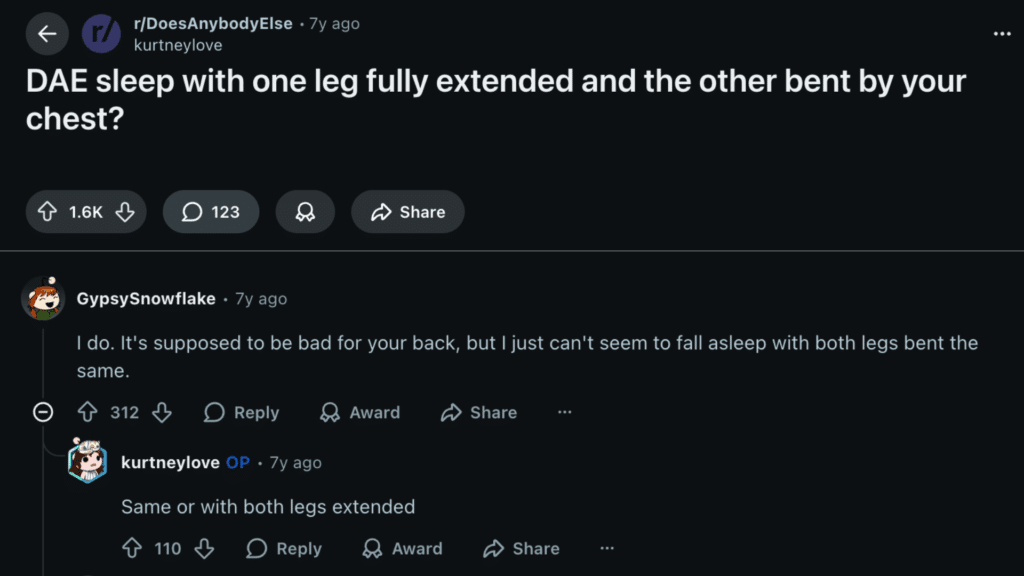
If you’ve ever wondered whether others sleep like this too, you’re far from alone. In the Reddit thread “DAE sleep with one leg fully extended and the other bent?”, hundreds of people admitted they do the exact same thing.
Most described it as the most natural way to fall asleep; comfortable, cooling, and oddly grounding. Some said they can’t rest any other way, while others mentioned it started in childhood and became an unconscious habit.
A few even joked it’s their “default sleep setting,” especially on hot nights when keeping one leg out helps them stay cool.
Personally, I found it reassuring to read that this position is so common. I’ve slept this way for years without thinking much about it, and it’s interesting to see that so many others find the same comfort and balance in that one-leg-bent posture.
It’s a small reminder that our bodies naturally pick what feels best, even when we’re not aware of it.
When to Adjust Your Sleeping Style
Even if this posture feels natural, your body might still be signaling that it needs a change. Watch for these signs that it’s time to adjust your sleeping style.
| Situation | What Happens | Better Option |
|---|---|---|
| Constant Pain or Stiffness | Waking up sore or stiff most mornings could mean your spine or hips aren’t aligned properly. | Try side sleeping or use a thinner pillow for better support. |
| Breathing or Snoring Issues | Lying face down can restrict airflow and worsen snoring in some people. | Side sleeping improves breathing and keeps your spine neutral. |
| Pregnancy or Chronic Pain | Stomach sleeping adds pressure to your abdomen and back, which can be risky during pregnancy or painful for those with spinal issues. | Use a body pillow and sleep on your side for safer, better support. |
Even small shifts, like adjusting your pillows or switching to a supportive side-sleeping setup, can make a big difference in how your body feels each morning.
When to See a Doctor
If you notice ongoing pain, numbness, or restless sleep that doesn’t improve with simple changes, it’s worth checking with a doctor or physical therapist.
You might have an underlying issue, such as a muscle imbalance, joint irritation, or restless legs syndrome, that needs targeted care.
Common Mistakes to Avoid when Sleeping with Knees Bent
Even small habits can make a comfortable position less healthy over time. Many people don’t realize how little adjustments, like pillow height or leg angle, can affect how their body feels in the morning.
- Using a thick pillow: A high or firm pillow pushes your neck out of alignment, leading to stiffness and tension. A thin or soft pillow keeps your neck closer to neutral.
- Letting your hips twist too far: When one knee bends too high, your pelvis rotates unevenly. Placing a small pillow under your hips or beside your bent knee helps prevent this strain.
- Sleeping on a sagging mattress: A soft or uneven surface lets your spine sink, causing back pain. A medium-firm mattress supports your body evenly and keeps your posture balanced.
- Ignoring pain or numbness: Waking up sore or tingly isn’t normal. Small, consistent discomfort means it’s time to adjust your pillow setup or try a side-sleeping position.
A few mindful tweaks can turn this familiar habit into a posture that feels just as good when you wake up as it does when you fall asleep.
Final Thoughts
Now that you know more about why you sleep on your stomach with one leg bent, it’s easier to understand what your body might be asking for.
This habit often comes down to comfort, balance, or a little muscle tension from daily life. It’s harmless for many people, but the right pillow and mattress can make a big difference if you ever feel sore.
I’ve noticed small changes, like a lower pillow or a soft hip cushion, can turn restless nights into truly restful ones. Try a few tweaks and see what feels best for you.
If you enjoyed this post, take a look at more of my blogs for simple sleep tips and down-to-earth advice.


